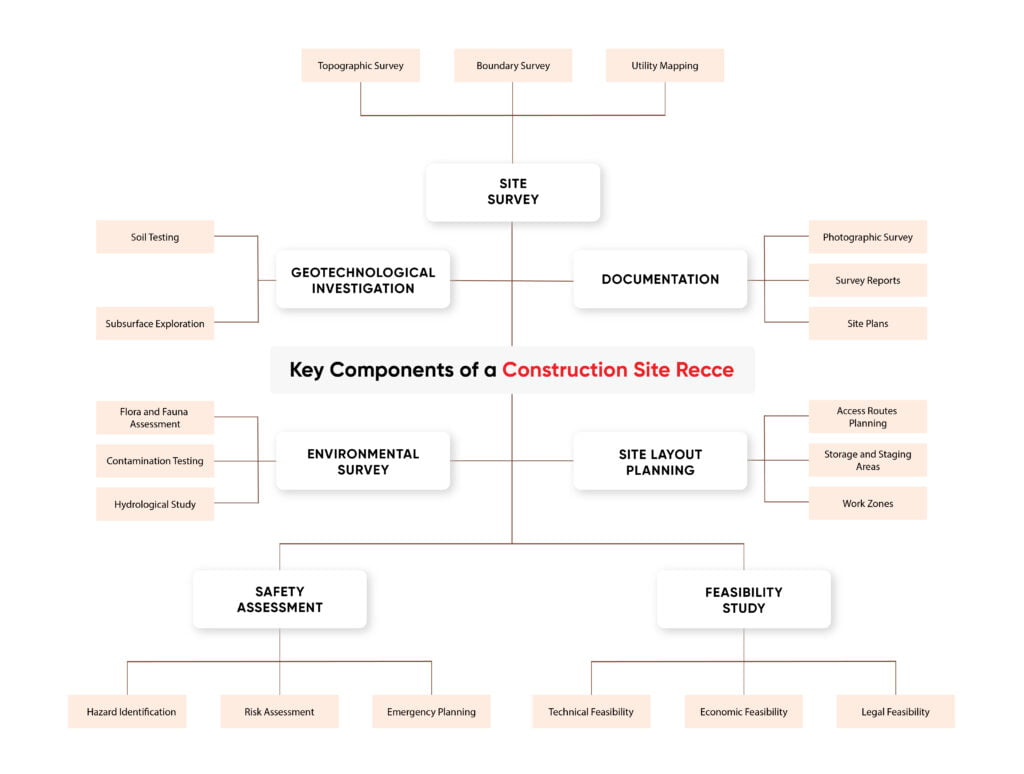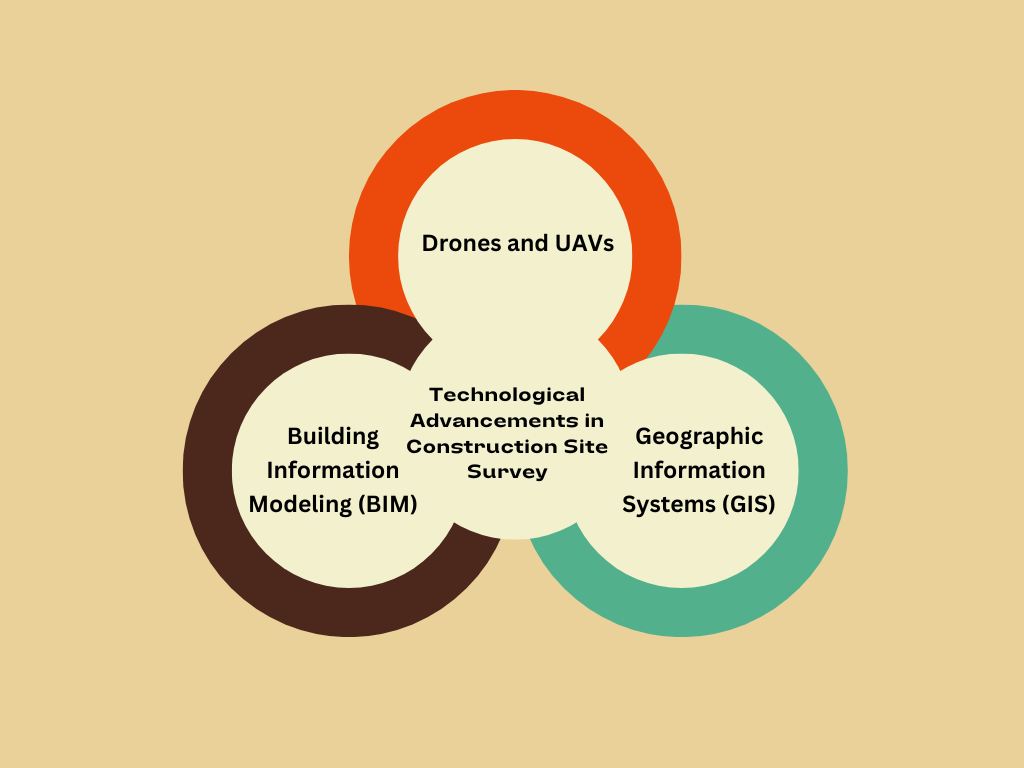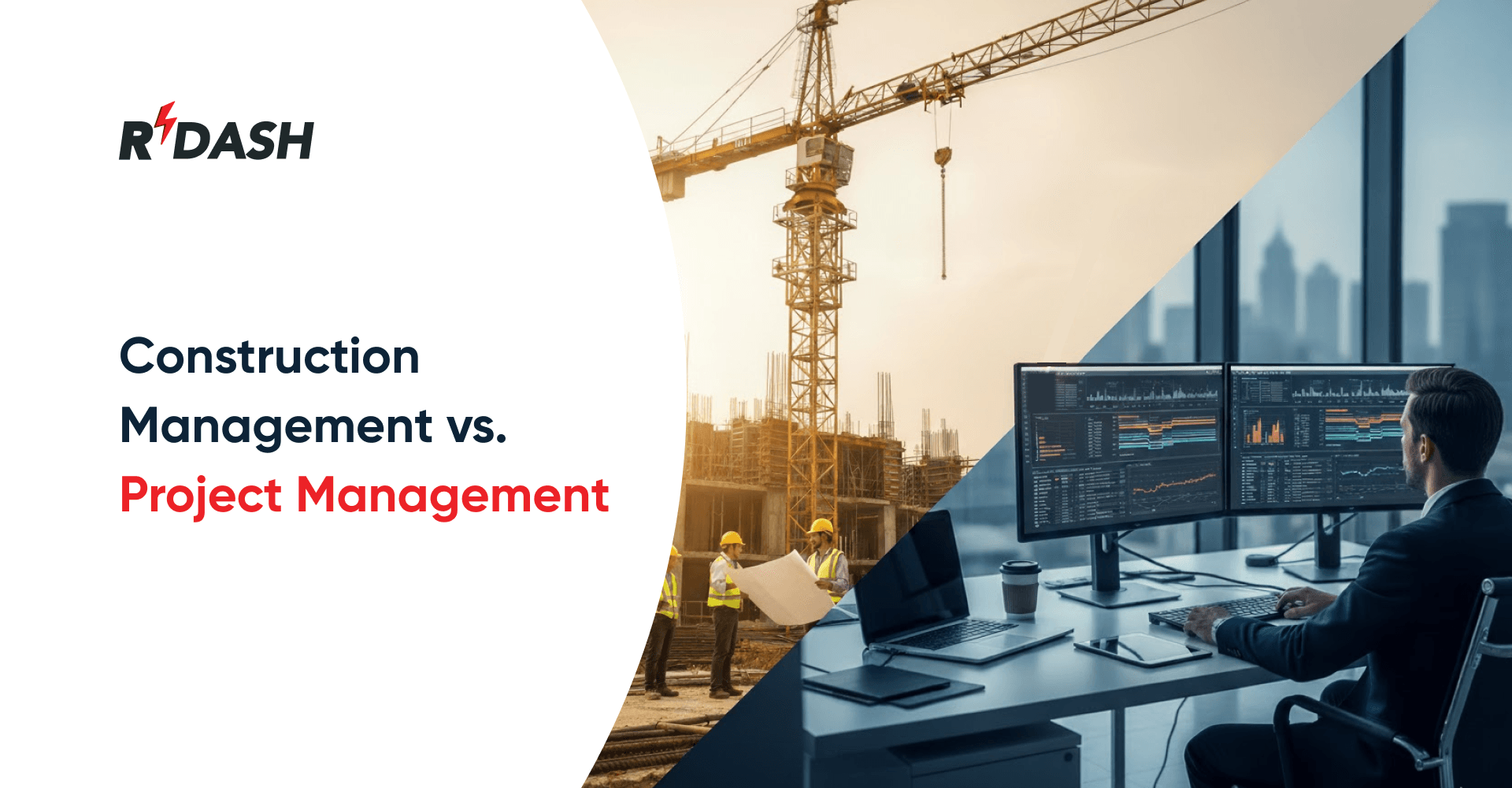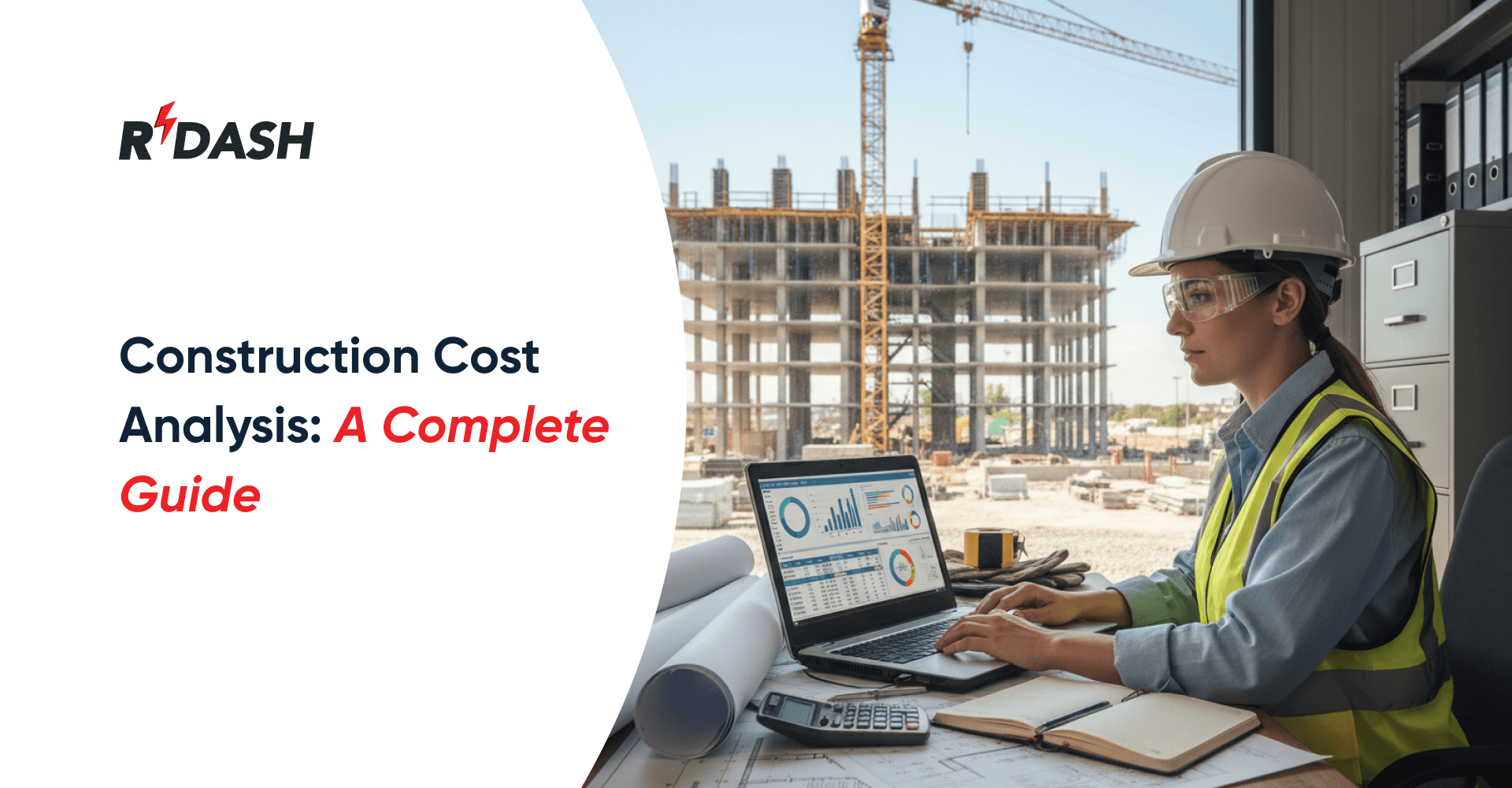Site surveys form the bedrock of any successful construction project. Before breaking ground, a meticulous site survey—often referred to as a reconnaissance (recce)—is conducted to gather critical information that will guide every subsequent phase of the project. This process is not merely a formality; it is an essential step that determines the feasibility, safety, and efficiency of the construction endeavor.
A site survey involves a detailed examination and assessment of the construction site, focusing on various factors such as topography, soil conditions, existing structures, environmental considerations, and legal regulations. By understanding these elements in depth, project managers can anticipate challenges and devise strategies to overcome them. In India, where construction projects must navigate a diverse array of geographical, climatic, and regulatory environments, the importance of a comprehensive site survey cannot be overstated.
Purpose of a Site Survey in Construction
The primary purpose of a recce at a construction site is to collect data that will inform the planning and design stages of a project. This information helps project managers, engineers, architects, and other stakeholders make informed decisions, mitigate risks, and ensure compliance with regulatory requirements. The main objectives include:

- Accurate Site Assessment : Provides a clear and precise understanding of the site’s physical and environmental conditions, essential for informed decision-making.
- Design Considerations : Ensures that structures are functional, safe, and compliant with local regulations, such as incorporating drainage systems in flood-prone areas.
- Risk Identification : Identifies potential risks, such as soil instability in earthquake-prone regions, allowing for the design of appropriate foundation types and structural reinforcements.
- Opportunity Analysis : Highlights opportunities that could benefit the project, such as proximity to essential utilities like water, electricity, and transportation networks.
- Budget and Schedule Optimization : Enables more accurate budgeting and scheduling by providing early insights into site conditions, thereby reducing the likelihood of delays and cost overruns.
- Regulatory Compliance : Ensures that the project adheres to local zoning laws, building codes, and environmental regulations, which is particularly important in diverse and regulated environments like India.
Key Components of a Construction Site Survey

A thorough site survey involves several key components, each of which provides critical data to support project planning and execution.
1. Site Survey
A site survey is the cornerstone of a construction site survey. It involves detailed measurements and observations to create an accurate representation of the site. Key elements include:
- Topographic Survey: Mapping the site’s contours, elevations, and significant features. This helps in understanding the terrain and planning the layout of structures.
- Boundary Survey: Determining the exact boundaries of the property to avoid legal disputes and ensure proper placement of structures.
- Utility Mapping: Identifying existing underground and overhead utilities, such as water, gas, electricity, and telecommunications, to prevent damage during construction.
2. Geotechnical Investigation
Understanding the soil and subsoil conditions is crucial for designing foundations and other structural elements. A geotechnical investigation involves:
- Soil Testing: Analyzing soil samples to determine their composition, strength, and load-bearing capacity.
- Subsurface Exploration: Using techniques like drilling and boring to study the subsurface conditions and identify any potential issues, such as rock formations or groundwater levels.
3. Environmental Survey
An environmental survey assesses the potential impact of the construction project on the surrounding environment. This includes:
- Flora and Fauna Assessment: Identifying protected species and habitats that need to be preserved or relocated.
- Contamination Testing: Checking for the presence of hazardous materials, such as asbestos or lead, which require special handling.
- Hydrological Study: Analyzing the site’s water drainage patterns and potential flood risks.
4. Safety Assessment
Safety is paramount in any construction project. A safety assessment aims to identify and mitigate potential hazards. Key considerations include:
- Hazard Identification: Recognizing site-specific risks, such as unstable ground, existing structures, and proximity to hazardous areas.
- Risk Assessment: Evaluating the likelihood and impact of identified hazards and developing strategies to manage them.
- Emergency Planning: Establishing procedures for responding to emergencies, including evacuation routes and first aid stations.
5. Feasibility Study
A feasibility study evaluates whether the proposed project is practical and achievable. It considers factors such as:
- Technical Feasibility: Assessing whether the design and construction plans are suitable for the site conditions.
- Economic Feasibility: Analyzing the project’s cost, budget, and financial viability.
- Legal Feasibility: Ensuring the project complies with all relevant laws, regulations, and zoning requirements.
6. Site Layout Planning
Effective site layout planning is essential for optimizing construction activities and ensuring smooth operations. This involves:
- Access Routes Planning: Identifying the best routes for transporting materials, equipment, and personnel to and from the site.
- Storage and Staging Areas: Designating areas for storing materials, equipment, and temporary structures.
- Work Zones: Organizing the site into specific work zones to enhance efficiency and safety.
7. Documentation
Comprehensive documentation is crucial for capturing all the information gathered during the recce. This includes:
- Photographic Survey: Taking detailed photographs of the site to document its current condition and any existing structures.
- Survey Reports: Compiling detailed reports that summarize the findings of the site survey, geotechnical investigation, and environmental survey.
- Site Plans: Creating detailed site plans that illustrate the layout, topography, and key features of the site.
Best Practices for Conducting a Construction Site Survey
To ensure a successful recce, it is important to follow best practices that enhance accuracy, efficiency, and safety. Here are some key recommendations:

1. Assemble a Multidisciplinary Team
A comprehensive site survey requires the expertise of professionals from various disciplines, including surveyors, engineers, environmental scientists, and safety experts. Assembling a multidisciplinary team ensures that all aspects of the site are thoroughly evaluated.
2. Use Advanced Surveying Equipment
Leveraging advanced surveying equipment, such as drones, GPS devices, and ground-penetrating radar (GPR), can significantly enhance the accuracy and efficiency of the site survey. These technologies enable precise measurements and detailed mapping of the site.
3. Conduct Regular Training
Regular training ensures that team members are up-to-date with the latest techniques, technologies, and safety protocols. This is particularly important for operating specialized equipment and handling hazardous materials.
4. Engage Stakeholders Early
Engaging stakeholders, including project owners, regulatory authorities, and local communities, early in the process can help identify potential concerns and obtain necessary approvals. This collaborative approach facilitates smoother project planning and execution.
5. Implement a Quality Assurance Program
A quality assurance program ensures that all aspects of the site survey are conducted to the highest standards. This includes regular audits, peer reviews, and adherence to industry best practices.
6. Prioritize Safety
Safety should be a top priority throughout the site survey process. This includes conducting thorough safety assessments, implementing risk management strategies, and ensuring all team members are trained in safety protocols.
7. Maintain Comprehensive Records
Maintaining detailed records of all findings, reports, and documentation is crucial for future reference and regulatory compliance. These records also serve as valuable resources for resolving disputes and making informed decisions during the project.
Technological Advancements in Construction Site Survey
The construction industry is increasingly adopting new technologies to enhance the efficiency and accuracy of site reconnaissance. Some of the key advancements include:

1. Drones and UAVs
Drones, or unmanned aerial vehicles (UAVs), have revolutionized site surveys by providing high-resolution aerial imagery and 3D mapping. They offer several advantages:
- Efficiency: Drones can cover large areas quickly, reducing the time required for site surveys.
- Accuracy: High-resolution images and 3D models provide detailed and accurate data for analysis.
- Safety: Drones can access hazardous or difficult-to-reach areas without putting surveyors at risk.
2. Geographic Information Systems (GIS)
GIS technology enables the integration and analysis of spatial data, providing valuable insights for site planning and management. Key benefits include:
- Data Integration: GIS can combine data from various sources, such as topographic maps, soil surveys, and utility maps, into a single platform.
- Visualization: Advanced visualization tools allow stakeholders to see and interact with spatial data in new ways, enhancing understanding and decision-making.
- Analysis: GIS tools enable complex spatial analyses, such as site suitability assessments and environmental impact studies.
3. Building Information Modeling (BIM)
BIM technology creates detailed 3D models of buildings and infrastructure, incorporating data on design, materials, and construction processes. Its applications in site recce include:
- Visualization: BIM provides detailed visualizations of proposed structures, helping stakeholders understand the project scope and design.
- Clash Detection: BIM can identify potential clashes or conflicts between different elements of the design, such as structural components and utilities.
- Lifecycle Management: BIM supports the entire lifecycle of a project, from planning and design to construction and maintenance, providing a comprehensive view of the site and its development.
RDash : Revolutionizing Site Surveys with Comprehensive Recce Practices
RDash approach to site surveys, or recce, is a game-changer for the construction industry. By going beyond basic measurements and addressing all aspects of the site, we provide a level of detail and insight that sets the stage for successful project execution. Our commitment to detailed reporting, addressing common industry challenges, and investing in expert training ensures that every project we touch is grounded in solid, actionable data. With RDash, you can be confident that your construction project will be planned and executed with the highest level of precision and professionalism.

- Comprehensive Recce Approach : At RDash, the ‘Recce’ process is designed to go far beyond a traditional site survey. We begin by thoroughly capturing all relevant site data, which includes not only the basic measurements but also detailed records of existing structural conditions. Our recce teams are trained to identify and document critical markers for essential services such as air conditioning, electrical systems, and plumbing infrastructure. This ensures that architects and engineers have all the necessary information at their fingertips before the design phase begins.
- Beyond Measurements—A Holistic View : While precise measurements are essential, RDash understands that successful project execution requires a broader understanding of the site. Our recce process includes gathering critical information about material movement guidelines as specified by the building’s developer. We identify designated areas for material storage and handling, ensuring that these locations are both accessible and secure. Additionally, we consider work shift timings to plan construction activities efficiently, and we meticulously document the structural layout of the site. This comprehensive approach ensures that all logistical and operational aspects of the site are well understood and accounted for.
- Detailed Reporting—Clarity and Precision: Once the recce is complete, RDash organizes all the gathered data into a detailed and structured report. This report serves as the first point of reference in discussions with clients. It includes all the site-specific information needed to align the project’s design and execution with the client’s expectations and requirements. The report is designed to be clear, precise, and easy to navigate, ensuring that nothing is overlooked. By providing this comprehensive document, RDash facilitates smoother communication and decision-making from the very start of the project.
- Addressing Industry Pain Points: A common challenge in the industry is that recces often miss critical details, leading to multiple site visits, wasted time, and increased project costs. RDash addresses these pain points head-on by implementing several key strategies. We start by creating detailed site survey checklists that guide our teams on what specific data points need to be captured. These checklists are tailored to each project, ensuring that nothing is missed. Additionally, we have developed standardized reporting formats that make it easy to organize and present data in a way that is useful for all stakeholders.
- Expert Training—Ensuring Excellence: To ensure that every recce is conducted to the highest standard, RDash invests in specialized training for all personnel involved in site surveys. Our training programs are designed to equip our teams with the skills and knowledge they need to conduct thorough and efficient recces. This includes not only technical training on how to use advanced surveying tools but also best practices for documenting and reporting findings. By focusing on training, RDash ensures that our teams are prepared to handle the unique challenges of each site, reducing the risk of errors and ensuring that projects stay on track from the very beginning.
Conclusion
Conducting a recce at a construction site is a critical step in ensuring the success of any construction project. By thoroughly assessing the site conditions, identifying potential risks, and planning accordingly, project stakeholders can make informed decisions that enhance efficiency, safety, and compliance. Following best practices and leveraging advanced technologies further improves the accuracy and effectiveness of the recce process. Ultimately, a well-executed plan lays the foundation for a successful construction project, minimizing risks and maximizing outcomes.
As technology continues to evolve, the process of conducting a recce will become even more efficient and precise, enabling construction professionals to tackle increasingly complex projects with confidence. Embracing these advancements and maintaining a commitment to thorough, detailed site assessments will remain essential for achieving project success and ensuring the safety and sustainability of construction endeavours.
FAQs
What is the main objective of a construction survey?
The main goal of a construction survey is to collect precise measurements and data regarding a site’s physical features, such as its boundaries, terrain, and existing conditions. This information is essential for accurate planning and designing of the construction project.
How does a pre-construction survey support grading and leveling of the site?
A pre-construction survey provides essential data on the land’s elevation and slope, helping contractors determine the required grading and leveling adjustments to ensure a stable and suitable foundation for construction.
What hazardous materials might land survey teams be responsible for identifying?
Land survey teams may be responsible for detecting hazardous substances such as asbestos, lead, toxic chemicals, or buried underground tanks, all of which could pose serious health and environmental risks.
Can a construction survey uncover hidden site problems?
Yes, construction surveys can uncover hidden problems such as unstable soil, drainage issues, or underground obstacles like old foundations or utility lines. Identifying these issues early helps to avoid costly delays and unexpected changes during construction.






